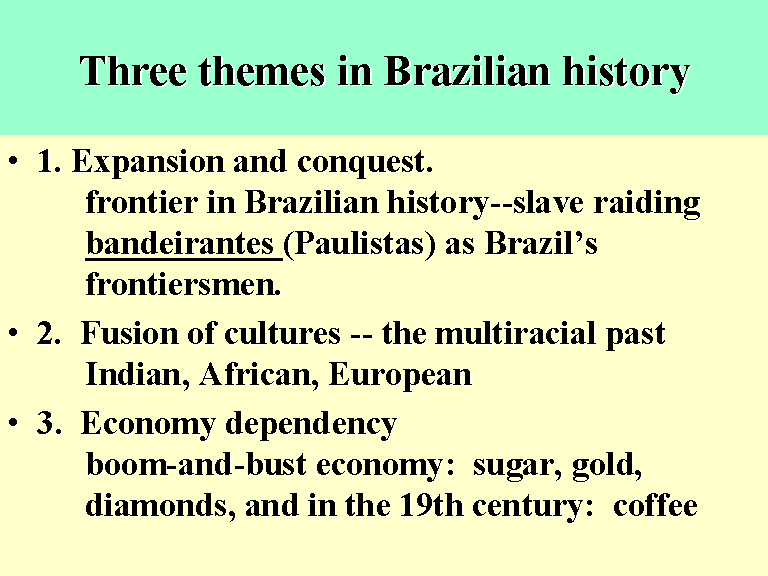
|
Brazil, 1500-1630: from Portuguese contact to Dutch conquest
3 themes in Brazilian history
- expansion and conquest
- fusion of cultures -- the multiracial past
- economic dependency
Geographical determinism of settlement patterns
- Indian: rainforest, coast, highlands
- Portuguese: cling to the coast
16th Brazil, slow pace of colonization
- brazilwood trade, degregados (exiled criminals)
- failure of captaincy generals
Sugar: sweet for Portuguese, bitter for Indian and African slaves
|
 |
Three themes in Brazilian history
1. Expansion and conquest. � frontier in Brazilian history--slave raiding� bandeirantes (Paulistas) as Brazil’s� frontiersmen.
2. Fusion of cultures -- the multiracial past� Indian, African, European
3. Economy dependency� boom-and-bust economy: sugar, gold,� diamonds, and in the 19th century: coffee
|
 |
Population of Brazil, 1500-1994 (millions--rough estimates)
1585 0.25 (200,000 Indians; 15,000 � black slaves; 35k whites/mixed)�1700 1 �1800 2.5 1/2 Black, 1/4 White, 1/4 Indian�1890 14 1/2 Black-Brown�1940 41 1/3 Black-Brown�1994 155
|
 |
Cultural �types at contact:�mainly bands�and tribes�in “Brazil”��
|
 |
Geographical determinism of settlement patterns: Native Americans to 1500
Rainforest
- Blackwater--acidic, low-oxygen water�foraging and fishing; thin soils, little agriculture
- Whitewater--high oxygen water laden with silt�creates floodplains (várzea) suitable for agriculture (e.g., Tapajos on T. River, major tributary of Amazon)
Coast: marine resources and agriculture permit emergence of towns (e.g., Tupinambá)
Highlands--semi-sedentary agriculture
Manioc: “as important to the food supply of the tropics as maize or potatoes is to the temperate zones”
|
 |
�Principal Physical Features.�Key (meters): �3000-5000�1000-3000�500-1000�200-500�sea level-200�
©Cambridge Encyclopedia of Latin America & the Caribbean
|
 |
Native settlement greatly determined by topography
Rainforests
- Blackwater--fishing and foraging
- Whitewater--& agriculture
Highlands--semi-sedentary
Southern plains�--semi-sedentary
|
 |
Areas of Tupi-Guaraní language family,� 16th century
Tupinambá
- lived along the coast
- exploited the resources of the sea and forests
- fought many small wars, revenge raids
- engaged in ritual cannibalism.
|
 |
16th Brazil, slow pace of colonization
Chance and the Portuguese in Brazil
- Treaty of Tordesillas, 1494: Portuguese to 370 leagues west of Cape Verdes; Spanish beyond...
- Pedro Cabral, 1500: “Isle of the True Cross”
- Immense expanse, little of commercial value
Slow settlement by Portuguese
- Asian and African trading forts were more valuable
- Brazilwood trade: harvested by natives for trinkets
- degregados (exiled criminals)
Defend against European interlopers
- 1516: fort at Pernambuco
- 1530s: 12 captaincy-generals established; 10 failed.
|
 |
16th century captaincy-generals did not prosper
Vast powers granted to C-G in perpetuity.
Only 2 prospered: Pernambuco and Sao Vicente
1548: 15 towns and hamlets totaling 2000 Portuguese.
1548: Tome de Sousa, named 1st governor general of Brazil
|
 |
Architectural�sites from 16th century Brazil
“Like crabs clinging to the coast”
3 principal zones:
- Pernambuco
- Salvador de Bahia
- Sao Vicente (Sao Paulo)
|
 |
Brazilwood, the first “boom” lasted 4 decades (1510-1550)
Brazilwood-- “brasas” (as in glowing coal) red dye in great demand in Europe
Royal dyewood monopoly established
Natives logged the timber in exchange for knives, axes, and trinkets
Portuguese struggle for justice, slow to begin
- Jesuits--first order to enter Brazil (1548)
- Used the aldeia system to concentrate “peaceful” natives into hamlets
- Left others at the “mercy” of slave-raiders
- 1566--junta to debate the Indian question
- 1570--King Sebastao ruled that Indians on “no account and in no way be enslaved.”
|
 |
Portuguese struggle for Justice�1548 with arrival of 6 Jesuits
Jesuit Manuel de Nóbrega (1517-1570): “They are not certain about any god, and believe anyone who tells them he is a god... A few letters will suffice here, for it is all a blank page. All we need to do is to inscribe on it at will the necessar
y virtues, be zealous, and ensure that the Creator is known to these creatures of His.”
Founded schools and missions (e.g., Sao Paulo, 1562) to convert and protect Indians from slavers and settlers
The aldeia system: missions for converting, christianizing (marriage, family) and protecting Indians; exposed them to disease and slave raiders
|
 |
17th century�architectural�sites
More densely settled with few new sites
Greatest expansion occurred in sugar-plantation regions in Northeast
|
 |
In 1970, high population densities on the coast still reflect topography and colonial settlement patterns
|
 |
Sugar: sweet for Portuguese, bitter for Indian and African slaves
First introduced in 1526 (Pernambuco)
Labor requirements for sugar cane much greater than for Brazilwood
- Among the Tupi agriculture was women’s work
- Native village governance pattern did not support labor draft system
- Disease (smallpox, 1562) depopulated the villages
- Indian slavery became widely used
Sugar mills, indicate expansion of cane
- 1570 60
- 1600 120
- 1650 350
- 1700 500
|
 |
Sugar-cane
Perfect temperature, soil and rainfall
Portuguese experience in the Atlantic islands
Sugar transformed from “a luxury of kings into the kingly luxury of commoners.”
|
 |
Engheno: 3-wheeled sugar mill first introduced in 1610 revolutionized production
|
 |
Three-wheeled sugar mill (1610) demanded much skilled, hard labor
|
 |
Refining sugar was a hot, exhausting, labor-intensive job
|
 |
Slave Traffic (figures in thousands): 1451-1600, beginning (1/4 million)�(P.D. Curtin, The Atlantic Slave Trade)
|
 |
Slave Traffic: 1601-1700. Brazil is main destination (of 1.3 million total)
|
 |
“Big House” of a 17th century sugar plantation (Bahia)
|
 |
End
|























